Addo
Addo and Addo-X
Anthea Agrell has kindly provided the following information about Addo:
"My grandfather, Hugo Agrell, founded Addo AB in Malmö, Sweden in 1918. My father took it to the US in 1950. As far as I know the company in the UK, in Cirencester, was a subsidiary of the Swedish company where my uncle became the MD.
What I do know with certainty is that my grandmother received the ceremonial keys to the town of Cirencester—where the factory which manufactured the machines was located—as a token of their enthusiasm that jobs were being created. I also remember the name of the British agents as being Ian Bulmer and his brother. They were located in London. I believe they did a pretty good job since as late as 1990 Addo-X's were still in use !"
In 1966 Addo was taken over by its Swedish competitor Facit, but was maintained as a separate subsidiary.
Addo are mainly known for their mechanical calculators. The full-keyboard machines have the name Addo and the 10-key machines have the name Addo-X (X from the Roman numeral for 10, maybe).
Some electronic calculators under the Addo-X range were manufactured in Britain. In 1974 'The Times' reported[1]:
"Addo, after the
merger with Facit into Facit-Addo last July, no longer manufactures calculators in Britain. The Facit-Addo range of machines is now made by the parent Facit company in Sweden, in the United States and in Japan".
Known Addo electronic calculators include:
- Addo Sabatronic
- Addo Ten/3, made in Britain.
- Addo Ten/3 MkII, made in Britain
- Addo-X 9354J, made in Japan.
- Addo-X 9364, made in Japan.
- Addo-X 9675, made in Britain.
A Selection of Addo Mechanical Calculators
ADDO Mod 9
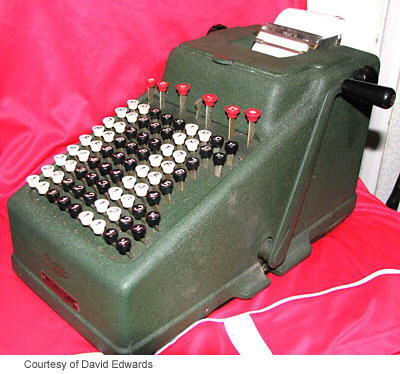
Addo Mod 9
Hand operated mechanical calculator. A 'Full-keyboard add-lister' for the old British sterling currency (£sd).
Intended for addition and subtraction with the result printed as a listing on the paper, though multiplication is possible using repeated addition.
Manufactured by Agrell.
Photographs kindly provided by David Edwards.
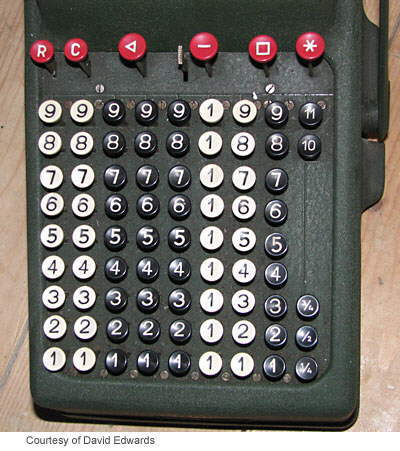
The Addo Mod 9 has 1/4, 1/2, and 3/4 keys for entering 1 farthing, 1 half-pence, and 3 farthings, respectively.
ADDO Mod 16
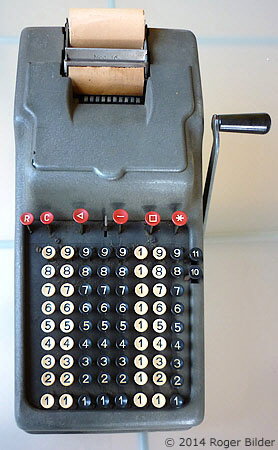
Addo Mod 16
Hand operated mechanical calculator. A 'Full-keyboard add-lister' for the old British sterling currency (£sd).
Intended for addition and subtraction with the result printed as a listing on the paper, though multiplication is possible using repeated addition.
Made in England by Agrell Manufacturing Co. Ltd.
Distributed by Bulmer's (Calculators) Ltd., 7-8 Poultry, London E.C.2.
Photograph kindly provided by Roger Bilder.
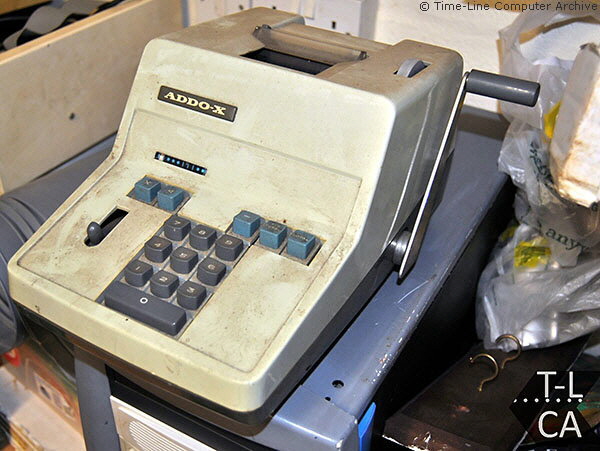
ADDO-X 331
Hand operated mechanical calculator. A 'Ten-key add-lister'. The 'X' of Addo-X is the Latin number 10, indicating a ten-key machine.
Intended for addition and subtraction with the result printed as a listing on paper, though multiplication is possible using repeated addition.
Made in Sweden by AB Addo.
Photographs kindly provided by the Time-Line Computer Archive.
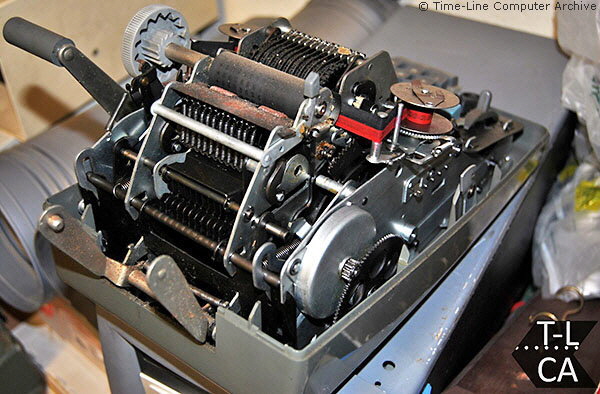
The intricate mechanism is revealed here with the top of the casing removed.
Addo Electronic Calculators
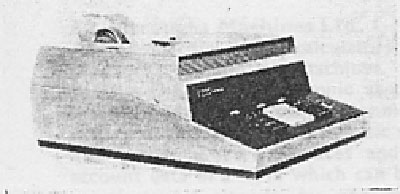
Addo Sabatronic
The magazine 'Office Methods & Machines' of April 1967 had details of this machine being exhibited at the Business Efficiency Exhibition[2]:
"New. Sabatronic electronic printing calculator with 20-digit capacity for addition, subtraction and multiplication and 19-digit capacity for division. 4 registers are flexible for constants and/or storage and back transfer is possible between all registers and keyboard. Positioning of decimal point in print-out is automatic."
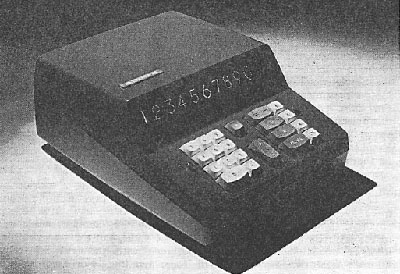
Addo Ten/3
The magazine 'Wireless World' reported in November 1968[3]. It is illuminating to see that it includes a description of how to use
one of these new-fangled electronic calculators:
"Electronic Desk Calculator
Details of a British designed and built desk calculator, the first in the world to use large scale
integration (l.s.i) have been released by Addo Ltd. This portable instrument, measuring 240 x 320 x 135mm and weighing only 6kg, performs the basic functions of "add", "subtract", "multiply" and "divide", showing the result
on a ten-digit visual register. Its operating speed can be gauged from its ability to multiply 10 x 10 digits in 200 ms. The instrument is simple to operate; factors and instructions are entered by depressing keys in
the same sequence used when putting pen to paper and the digits remain visible until the first digit of the second or subsequent factor is entered. Decimal point location is automatic. The keys actuate magnetically
operated reed switches. Digits over the ten digits displayed are stored by an overspill facility for subsequent examination and lost information is always the least significant. Thus the ten most significant digits in
all calculations are displayed, with the decimal point correctly positioned. Figures in the visual register can be transferred to a memory register and if these digits carry a plus or minus sign they will add to, or subtract
from, figures already in store and display the stored total to this point. The stored figure can be recalled for use in further calculations, and retained in memory. A constant in both multiplication and division can be
provided by depressing the appropriate key. The calculator is completely silent in operation with no clicks from the keys when they are depressed. The solid state circuitry is divided into a number of plug-in modules
making for easy servicing in the field and the small size of the unit is due mainly to the incorporation of the l.s.i. circuits. These devices which comprise some hundreds of interconnected transistors were developed by
General Instrument Ltd., and are produced in their U.K. plant. Three l.s.i. packages containing a metal thick oxide silicon chip are employed in each machine as a shift register storage and calculating unit. The
indicator tubes are a recent addition to the S.T.C. range, type GNP-7AH, side-view tubes with two decimal points included in each tube. They are opreated by time-shared drive circuits and have a peak current capability of
25mA. Designated type Ten/3 the Addo electronic calculator is stated to cost about £400 and this price is expected to make a large impact on this Japanese-dominated market. Addo Ltd., 85 Great North Road, Hatfield,
Herts."
The magazine 'Office Methods & Machines' of December 1968 also had an article about this machine explaining how it worked[4].
"Addo confidently expect their new Ten/3 electronic calculator, which uses large scale integrated circuitry to keep the price low and reliability high, to present a major threat to Japanese domination of this
market.
Instead of writing a mathematical problem on paper, the problem is pressed out on keys in the same sequence and a series of calculations takes place in the machine. When an equals key is pressed,
the answer appears on the screen. If a decimal point is involved, the machine places it in the correct position automatically.
... The new calculator, called the Addo Ten/3, was nicknamed SAM - Simple
Applied Mathematics - by Addo and the General Intrument Co. (U.K.) Ltd. who pooled their expertise to perfect it. General Instrument's major contribution was the large-scale integrated circuitry which has helped to keep down
costs and improve reliability. ...
... The calculator is highly portable measuring only 240 x 320 x 135 mm and weighing 6Kg. ... The price is £360 [GBP, about US$900] ... ."
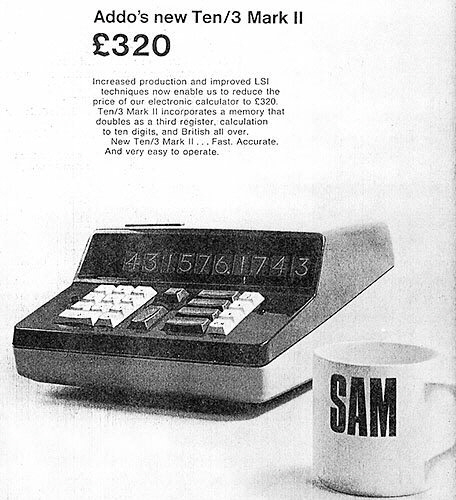
Advertisement for the ADDO Ten/3 Mark II from 1970.
From the previous calculator, above, 'SAM' = "Simple Applied M athematics".
Addo Ten/3 Mark II
In April 1970 the magazine 'Management in Action' had an advertisement[5]:
"For £320 you can posses our new model.
This is Addo's new Ten/3 Mark II. Our very calculating model - comes electrified - with even more integrated circuits. An unfailing memory that doubles
as a third register. A ten digit display. And is British all over. ..."
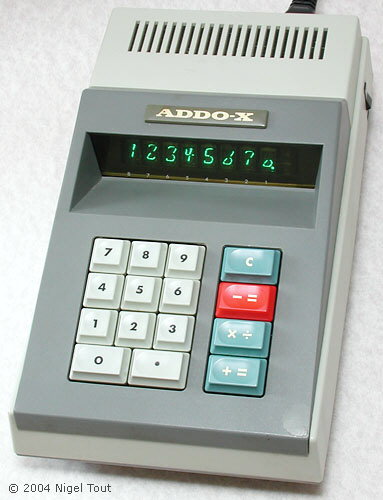
Addo-X 9354J
Power source - AC.
Display is 8-digits, stylised green Vacuum Fluorescent Display (Itron VFD) tubes, with half-height zeros.
4-functions.
Main integrated circuits made by Rockwell, in this example date-coded to mid-1970.
245 x 132 x 70 mm. (9.6" x 5.2" x 2.75").
Made in Japan.
Manufactured by Sharp, and is a version of the Sharp QT-8D.
In May 1970 this model was advertised at a price of £199 (GBP)[6] [about US$500].
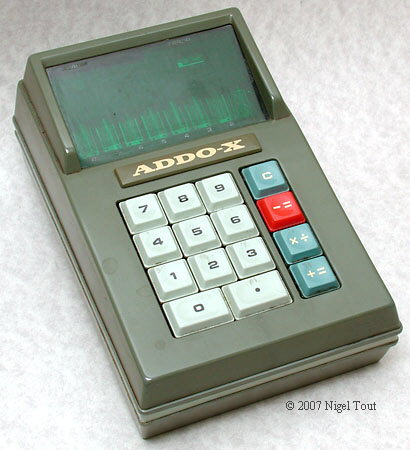
Addo-X 9364
Power source - rechargeable battery pack containing six AA cells.
Display is 8-digits, stylised green Vacuum Fluorescent Display (Itron VFD) tubes, with half-height zeros.
4-functions.
Main integrated circuits made by Rockwell, in this example date-coded to mid-1970.
245 x 132 x 70 mm. (9.6" x 5.2" x 2.75").
Made in Japan.
Made about 1970 by Sharp, and is a version of the Sharp EL-8.
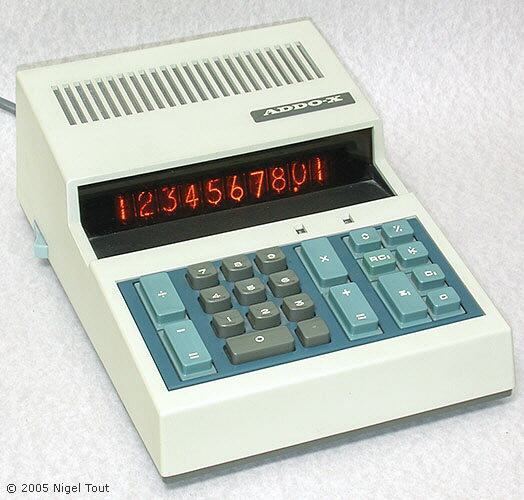
Addo-X 9675
Power source - AC.
Display is 10 digits, "Nixie"- type tubes.
4-functions, %, memory.
Main integrated circuits - Plessey 7-item chipset with MP931B, MP932B, MP933B, MP934B, MP935B, MP936B, MP937B.
275 x 197 x 97 mm (11.8" x 7.75" x 3.8").
Made in the United Kingdom.
Made about 1972.
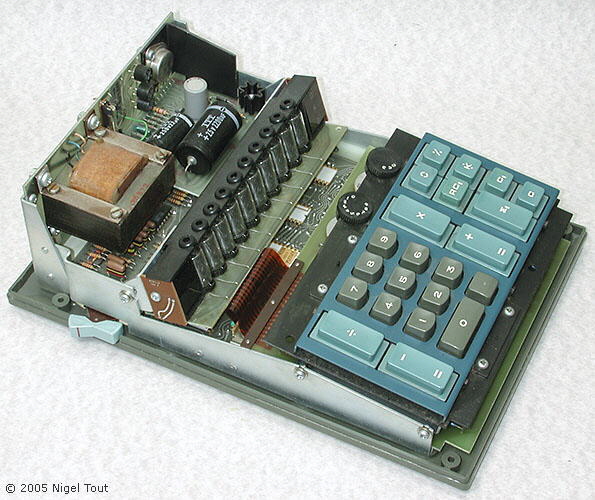
Here the cover has been removed to reveal the "Nixie"-type tubes, with the display-driver board behind under the power supply, and the main calculating board at the bottom.
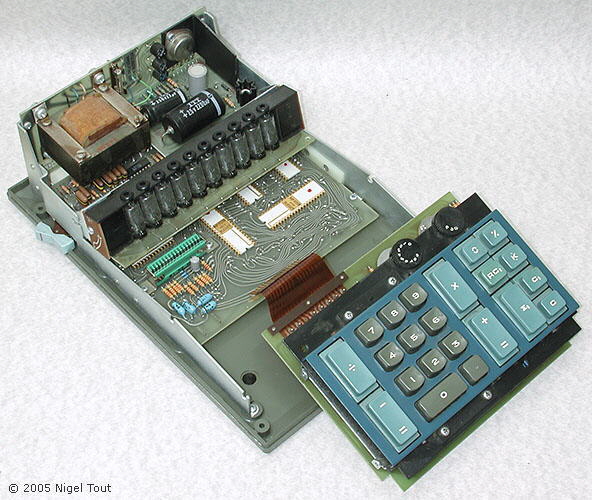
Removing the keyboard reveals the main calculating board.
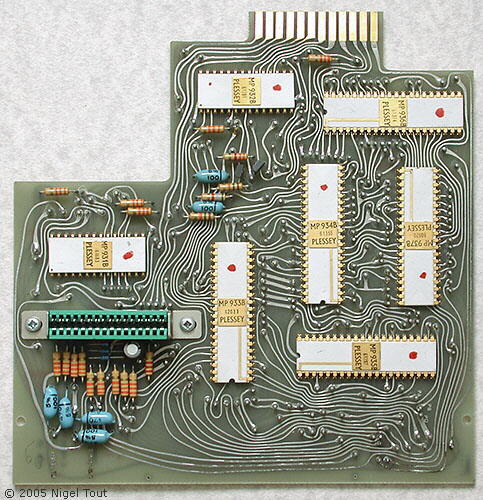
The main calculating board with the 7-piece chip-set manufactured by Plessey.
This is one of the few calculator chip-sets manufactured by Plessey. It looks to be quite costly since it requires 7 ceramic encased integrated circuits. This calculator is believed to date from about 1972, and by then both Mostek and Texas Instruments were putting the electronics of a 4-function calculator in one small plastic encapsulated integrated circuit. So a chip-set like this would then not have been competitive.
Plessey was a major company in Britain involved in radio and television-chassis production, but is especially noted for being at the forefront of developments in electronic telephone exchanges throughout the 1960s, 1970s, and 1980s. It was taken over by GEC-Siemens in 1989.
References:
- Owen, Kenneth, "American link expands range and techniques", The Times, 15 February, 1974.
- Office Methods & Machines, April 1967, p33.
- "New Products", Wireless World, November 1968, p423.
- "Made in Britain", Office Methods & Machines, December 1968, pp28-29.
- Management in Action, April 1970.
- Management in Action, May 1970.
Vintage British Calculators
Text & photographs copyright, except where stated otherwise, © Nigel Tout 2000-2025.